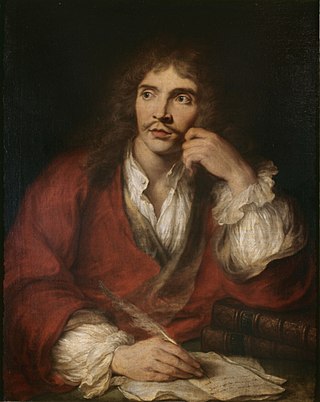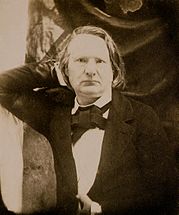
In poetry, a hendecasyllable is a line of eleven syllables. The term may refer to several different poetic meters, the older of which are quantitative and used chiefly in classical poetry, and the newer of which are syllabic or accentual-syllabic and used in medieval and modern poetry.
Hexameter is a metrical line of verses consisting of six feet. It was the standard epic metre in classical Greek and Latin literature, such as in the Iliad, Odyssey and Aeneid. Its use in other genres of composition include Horace's satires, Ovid's Metamorphoses, and the Hymns of Orpheus. According to Greek mythology, hexameter was invented by Phemonoe, daughter of Apollo and the first Pythia of Delphi.
In poetry, metre or meter is the basic rhythmic structure of a verse or lines in verse. Many traditional verse forms prescribe a specific verse metre, or a certain set of metres alternating in a particular order. The study and the actual use of metres and forms of versification are both known as prosody.
An iamb or iambus is a metrical foot used in various types of poetry. Originally the term referred to one of the feet of the quantitative meter of classical Greek prosody: a short syllable followed by a long syllable. This terminology was adopted in the description of accentual-syllabic verse in English, where it refers to a foot comprising an unstressed syllable followed by a stressed syllable. Thus a Latin word like íbī, because of its short-long rhythm, is considered by Latin scholars to be an iamb, but because it has a stress on the first syllable, in modern linguistics it is considered to be a trochee.

A caesura, also written cæsura and cesura, is a metrical pause or break in a verse where one phrase ends and another phrase begins. It may be expressed by a comma (,), a tick (✓), or two lines, either slashed (//) or upright (||). In time value, this break may vary between the slightest perception of silence all the way up to a full pause.

The Sapphic stanza, named after Sappho, is an Aeolic verse form of four lines. Originally composed in quantitative verse and unrhymed, since the Middle Ages imitations of the form typically feature rhyme and accentual prosody. It is "the longest lived of the Classical lyric strophes in the West".
Syllabic verse is a poetic form having a fixed or constrained number of syllables per line, while stress, quantity, or tone play a distinctly secondary role — or no role at all — in the verse structure. It is common in languages that are syllable-timed, such as French or Finnish — as opposed to stress-timed languages such as English, in which accentual verse and accentual-syllabic verse are more common.
Scansion, or a system of scansion, is the method or practice of determining and (usually) graphically representing the metrical pattern of a line of verse. In classical poetry, these patterns are quantitative based on the different lengths of each syllable. In English poetry, they are based on the different levels of stress placed on each syllable. In both cases, the meter often has a regular foot. Over the years, many systems have been established to mark the scansion of a poem.
Iambic pentameter is a type of metric line used in traditional English poetry and verse drama. The term describes the rhythm, or meter, established by the words in that line; rhythm is measured in small groups of syllables called "feet". "Iambic" refers to the type of foot used, here the iamb, which in English indicates an unstressed syllable followed by a stressed syllable. "Pentameter" indicates a line of five "feet".

Heroic verse is a term that may be used to designate epic poems, but which is more usually used to describe the meter(s) in which those poems are most typically written. Because the meter typically used to narrate heroic deeds differs by language and even within language by period, the specific meaning of "heroic verse" is dependent upon context.
Decasyllable is a poetic meter of ten syllables used in poetic traditions of syllabic verse. In languages with a stress accent, it is the equivalent of pentameter with iambs or trochees.
The Iambic trimeter is a meter of poetry consisting of three iambic units per line.
Accentual-syllabic verse is an extension of accentual verse which fixes both the number of stresses and syllables within a line or stanza. Accentual-syllabic verse is highly regular and therefore easily scannable. Usually, either one metrical foot, or a specific pattern of metrical feet, is used throughout the entire poem; thus one can speak about a poem being in, for example, iambic pentameter. Poets naturally vary the rhythm of their lines, using devices such as inversion, elision, masculine and feminine endings, the caesura, using secondary stress, the addition of extra-metrical syllables, or the omission of syllables, the substitution of one foot for another.
This is a glossary of poetry.
Latin prosody is the study of Latin poetry and its laws of meter. The following article provides an overview of those laws as practised by Latin poets in the late Roman Republic and early Roman Empire, with verses by Catullus, Horace, Virgil and Ovid as models. Except for the early Saturnian poetry, which may have been accentual, Latin poets borrowed all their verse forms from the Greeks, despite significant differences between the two languages.
Generative metrics is the collective term for three distinct theories of verse structure advanced between 1966 and 1977. Inspired largely by the example of Noam Chomsky's Syntactic Structures (1957) and Chomsky and Morris Halle's The Sound Pattern of English (1968), these theories aim principally at the formulation of explicit linguistic rules that will generate all possible well-formed instances of a given meter and exclude any that are not well-formed. T.V.F. Brogan notes that of the three theories, "[a]ll three have undergone major revision, so that each exists in two versions, the revised version being preferable to the original in every case."
Polish alexandrine is a common metrical line in Polish poetry. It is similar to the French alexandrine. Each line is composed of thirteen syllables with a caesura after the seventh syllable. The main stresses are placed on the sixth and twelfth syllables. Rhymes are feminine.
1 2 3 4 5 6 7 1 2 3 4 5 6 o o o o o S x | o o o o S x Moja wdzięczna Orszulo, bodaj ty mnie była S=stressed syllable; x=unstressed syllable; o=any syllable.
Czech alexandrine is a verse form found in Czech poetry of the 20th century. It is a metre based on French alexandrine. The most important features of the pattern are number of syllables and a caesura after the sixth syllable. It is an unusual metre, exhibiting characteristics of both syllabic and syllabotonic (accentual-syllabic) metre. Thus it occupies a transitional position between syllabic and accentual patterns of European versification. It stands out from the background of modern Czech versification, which is modeled chiefly after German practice.

The French alexandrine is a syllabic poetic metre of 12 syllables with a medial caesura dividing the line into two hemistichs (half-lines) of six syllables each. It was the dominant long line of French poetry from the 17th through the 19th century, and influenced many other European literatures which developed alexandrines of their own.
The Latin rhythmic hexameter or accentual hexameter is a kind of Latin dactylic hexameter which arose in the Middle Ages alongside the metrical kind. The rhythmic hexameter did not scan correctly according to the rules of classical prosody; instead it imitated the approximate sound of a typical metrical hexameter by having roughly the same number of syllables and putting word accents in approximately the same places in the line.








